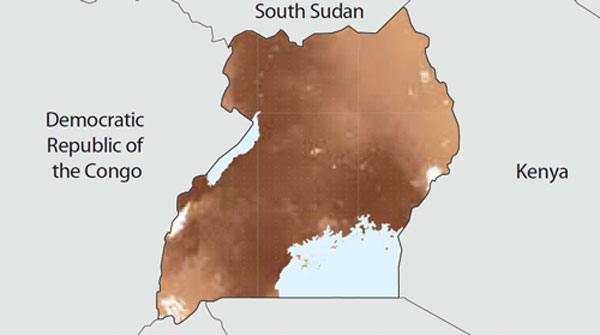Uganda
Official Name Republic of UgandaTotal area 241,038 sq km
Population 34,758,809 (July 2013 est.)
Capital City Kampala
Map

Background
Beginning in the late 19th century, the area was ruled as a colony by Great Britain, who established administrative law across the region. In 1962, Uganda gained its independence. Ever since, Uganda’s history has consisted of sporadic conflicts, most recently a protracted civil war against the Lord’s Resistance Army, which resulted in tens of thousands of deaths and displaced more than a million people.
The official languages are Swahili and English. Luganda, a southern language, is widely spoken across the country, and multiple other languages are also spoken.
Economy
Uganda has considerable natural resources, including fertile soils, regular rainfall, small deposits of copper, gold, and other minerals, along with recently discovered oil. Agriculture is the most important sector of the economy, employing over 80% of the work force. Currently, the bulk of export revenues is coffee.
Since 1990, economic reforms piloted a period of concrete economic growth, founded on sustained investment in infrastructure, better inducements for production and exports, lower inflation, improved domestic security, in addition to the return of exiled Indian-Ugandan entrepreneurs. Uganda has also been the recipient of about $2 billion in multilateral and bilateral debt relief. The global economic recession impaired Uganda’s exports. Nonetheless, Uganda’s GDP growth has greatly improved due to past reforms and thorough management of the recession. It is expected that oil revenues and taxes will become a larger source of government funding in the next few years.
Volatility in South Sudan poses a risk for the Ugandan economy, as Uganda’s main export partner is Sudan, and it is also a key destination for Sudanese refugees. Economic development and investor confidence are inhibited by unreliable power, high energy costs, inadequate transportation infrastructure, and corruption
Health
The removal of user fees at state health facilities in 2001, caused an 80% increase in visits to the facilities, with over half being from the poorest 20% of the population. This policy has been brought up as a key factor in helping Uganda achieve its Millennium Development Goals. However, many users are denied care if they don’t provide their own medical equipment.
The provision of support for poor and rural residents, along with the extension of public and private partnerships, has been identified as important provisions to allow vulnerable populations access to health facilities.
Major infectious diseases:
Food or waterborne diseases: bacterial diarrhea, hepatitis A, and typhoid fever
Vectorborne diseases: malaria, plague, and African trypanosomiasis (sleeping sickness)
Water contact disease: schistosomiasis
Malaria Status
In Uganda, malaria is the leading cause of morbidity and mortality, accounting for 25% to 40% of outpatient visits to health facilities, as well as 15% to 20% of all hospital admissions, and 9% to 14% of all hospital deaths. Approximately half of inpatient deaths among children under the age of five are attributed to malaria.
In most areas of Uganda, the temperature and rainfall allow steady, perennial, high level malaria transmission with comparatively little seasonal variability.
Poor people tend to live in environments conducive to mosquito breeding and malaria transmission. Consequently, malaria enhances poverty, which in turn causes poor disease management thereby trapping people in a malaria-poverty cycle. Despite the burden imposed by malaria, there is rising optimism that through the establishment of several recent large-scale initiatives, this will be changed. The United States government recently launched the President’s Malaria Initiative (PMI), with the goal of reducing malaria-related deaths in selected countries, including Uganda, by 50% within five years. Through PMI and other large funding sources, such as the Global Fund to Fight AIDS, Tuberculosis and Malaria, Uganda and other Africa countries have an unprecedented opportunity to reduce malaria associated morbidity and mortality on a national scale.
Innovative approaches to malaria control aimed at high-risk populations are urgently needed to achieve these goals.
SEARCH
TESTIMONIALS
-
The African Development Bank is pleased to invite you to a presentation from InRaD (Innovative Research and Development Corporation) on their latest innovation to fight m ...Egyptian Innovation: A Green Cure for Malaria
-
Field trail using Sunlight activated Formulated Extract (SAFE) to target and control Mosquito larvae (The Vector of malaria and filarial diseases); Novel Egyptian Technology for mosquito control.Sudan Testimonial
-
In this regard, Her Excellency would like to express her appreciation for your endeavors, which contribute in developing the relations with the Nile basin countries speci ..."H.E." Fayza Abu El Naga
-
On behalf of the Government conclusion, I find the Egyptian extract extremely efficient in killing mosquito larvae which can ingest particles of this extract and its stri ...Uganda Virus Research Institution
-
Earlier this morning, we had a very good meeting with two of our compatriots, Dr. Walid A. Ali and Dr. Tarek A. El Tayeb of the innovative Research and Development (INRad ...Federal Democratic Republic of Ethiopia Ministry of Health
